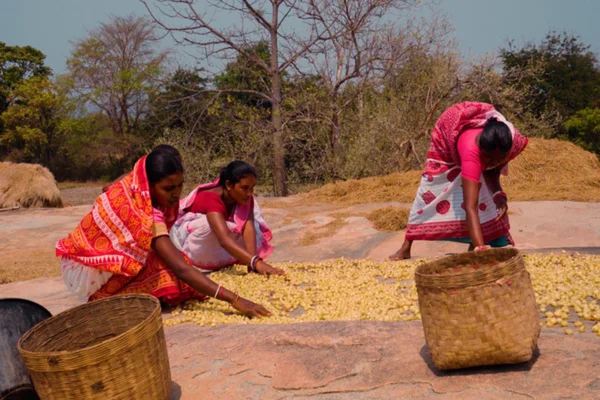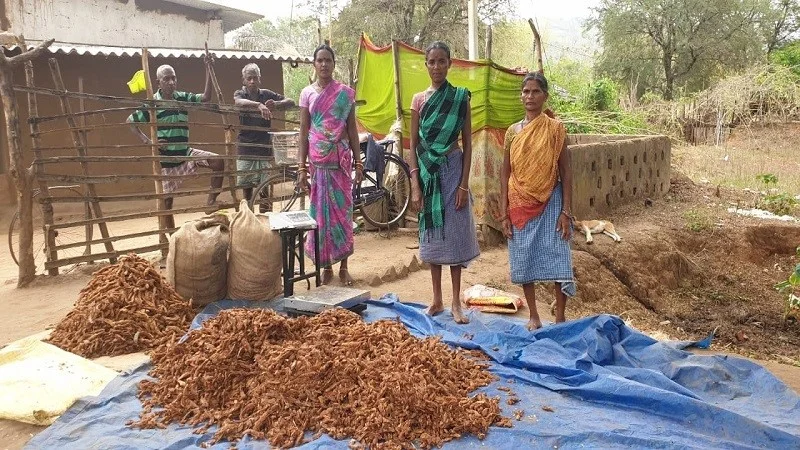LABHA Yojana aims to benefit Odisha’s large tribal population by providing a minimum support price for minor forest produce.
- Also, the establishment of a Commission for the Preservation and Promotion of Tribal Languages of the Scheduled Tribes of Odisha has been approved.
About the LABHA:
- TheLABHA aims to benefit the state’s large tribal population, constituting 23% of Odisha’s total population.
- It is a 100% State-funded minimum support price (MSP) scheme for minor forest produce (MFP).
- The MSP for MFP will be determined annually by the State government.
- The State government has initially allocated ₹100 crore for the scheme, with 2% commission for SHGs (Self Help Groups) or other designated agencies involved in procurement.
- The State government will set up a tamarind processing plant in one of its districts to add value to tamarind procured through LABHA Yojana and eliminate distress sales of produce to middlemen, ensuring fair returns for tribal communities.
How the scheme will be implemented?
- Primary collectors, mostly tribal individuals, will be able to sell MFP at the MSP through procurement centers managed by the Tribal Development Cooperative Corporation Limited of Odisha (TDCCOL).
- E-tendering, value addition, and processing units by TDCCOL are planned for further sales.
- The scheme integrates with Mission Shakti’s Women SHGs to ensure the involvement of women, who constitute the majority of primary collectors.
- Mission Shakti is Union Government’s umbrella scheme for safety, security and empowerment of women.
- Direct Benefit Transfer (DBT) will be used to transfer the amount to the beneficiaries’ accounts.
- The automated procurement systems, used in this scheme, aligns with the ‘Vision 5T’framework of the state government, which helps ensures transparency through technology.
- Automated procurement systems are a type of software that synchronizes all the collaborators, components, and sides of the supply chain.
About the Minor Forest Produce (MFP):
- The MFP is all non-timber forest produce of plant origin and includes bamboo, brushwood, stumps, canes, Tusser, cocoon, honey, waxes, Lac, tendu/kendu leaves, medicinal plants etc.
- The Scheduled Tribes and Other Traditional Forest Dwellers (Recognition of Forest Rights) Act, 2006 vests individual forest-dwellers rights to live in and get involved in Minor Forest Produce (MFP).
- The act, enacted in 2007, defines the MFP.
- The Panchayat Extension to Scheduled Areas (PESA) Act, 1996, empowers the forest-dwellers right to claim over forest produce.
- The “Minimum Support Price for Minor Forest Produce” is a scheme of Union government that is designed as a social safety net for improvement of livelihood of MFP gatherers by providing them fair price for the MFPs they collect.
- Tribal Co-operative Marketing Federation of India (TRIFED) is the is the nodal agency for the implementation of the scheme.
- The “PM Van Dhan Yojana,” is an initiative of the Ministry of Tribal Affairs and TRIFED, that seeks to improve tribal incomes through value addition of tribal products.
About Tribal Language Preservation Commission:
- Odisha is home to 21 tribal languages, and the commission aims to preserve, promote, and develop these languages.
- It will encourage multilingual education, document andpreserve tribal languages, promote their use, and protect linguistic rights.
- The commission will advocate for the inclusion of tribal languages like Ho, Mundari, Kui, and Saora in the 8th Schedule of the Indian Constitution.
- The 8th Schedule deals with the official languages in India, which presently includes 22 languages.
Ref: Source
| UPSC IAS Preparation Resources | |
| Current Affairs Analysis | Topperspedia |
| GS Shots | Simply Explained |
| Daily Flash Cards | Daily Quiz |
Frequently Asked Questions (FAQs):
What does the LABHA Yojana aim to achieve?
The LABHA Yojana aims to provide a minimum support price for minor forest produce, benefiting Odisha’s large tribal population.
How will the LABHA Yojana be implemented?
Primary collectors, mostly tribal individuals, will sell MFP at the MSP through procurement centers managed by TDCCOL, with e-tendering, value addition, and processing units planned for further sales.
What is the initial allocation for the LABHA Yojana by the State government?
The State government has initially allocated ₹100 crore for the LABHA Yojana.
What is the role of Mission Shakti in the LABHA Yojana?
Mission Shakti’s Women SHGs will be integrated into the scheme to ensure the involvement of women, who constitute the majority of primary collectors.



